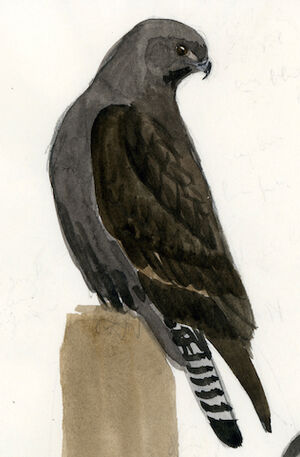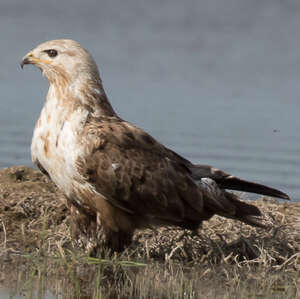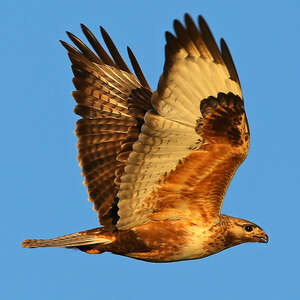Upland Buzzard
Buteo hemilasius - Buse de Chine
Identification
Upland Buzzard is larger than Buteo rufinus (Long-legged Buzzard) up to 70 cm, so size is essential to its identification. There are two possible forms, either very dark brown or almost black throughout the body, or much lighter. In this case, the head is pale, almost white, with a light brown cap, the eye is black with a yellow eye ring, and there is also a brown line on the head. The chest and throat are white, striped with dark brown marks. If you can observe from close proximity, then visible are the thighs and tarses completely covered with dark brown plumage, and this is what distinguishes it from Buteo rufinus which has the plummage more rust-colored, with less feather coverage (Long-legged buzzard in English!), and they may inhabit the same territories. The nape is light, the mantle and coverts remain dark brown. In flight, the Upland Buzzard shows very clear white marks on the primary coverts and a brown and white striped tail. The underside of the wing is white, with beige to dark brown coverts, which are black on the darker-form individuals. Identifying Buteo rufinus and Buteo hemilasius is easy for the lighter forms, but for the darker or black forms, it is much more difficult, and only the striped tail with more prominent white color with Buteo hemilasius, and size make the difference.
Subspecific information monotypic species
Foreign names
- Buse de Chine,
- Busardo mongol,
- bútio-do-planalto,
- Mongolenbussard,
- mongol ölyv,
- Mongoolse Buizerd,
- Poiana degli altipiani,
- mongolvråk,
- Mongolvåk,
- myšiak východný,
- káně stepní,
- Højlandsvåge,
- mongolianhiirihaukka,
- aligot de Mongòlia,
- Heiðavákur,
- myszołów mongolski,
- kalnu klijāns,
- azijska kanja,
- Мохноногий курганник,
- オオノスリ,
- 大鵟,
- mongolvråk,
- 大鵟,
Voice song and call
Habitat
Behaviour character trait
Migrating in groups of up to 30 to 40 individuals, they travel away from harsh winter zones to as far south as China or to the south slopes of the Himalayas. Often perching on rocky promontories or electrical poles close to settlements, the Upland Buzzard flies and glides at a high altitude in order to spot its prey.
Dietfeeding habits
Reproduction nesting
The couple builds their nest in cliff faces, mountain slopes, and near rivers. The nest is made out of twigs, grass, and tufts of wool, with a diameter of about one meter. We have observed couples that have two nests that they alternate between. Two to four eggs hatch in April or May and the young take flight after 45 days.
Geographic range
Threats - protection
Sources of information
- IOC World Bird List (v15.1), Gill, F and D Donsker (Eds). 2025-12-07.
- Vol. 2 - Handbook of the Birds of the World, Josep del Hoyo-Andrew Elliot--Jordi Sargatal
- A Photographic GUIDE TO THE BIRDS OF INDIA, Bikran Grewal, Bill Harvey, Otto Pfister
- A Field Guide to the Birds of the Indian Subcontinent, Krys Kazmierczak, Ber Van Perlo
- Wikipédia, Wikipedia, The Free Encyclopedia
- Birds of Kazakhstan,
- Planet of Birds,
- Oriental Bird Club,
Other sources of interest
 Specification sheet created on
31/07/2023 by Anne et Gabriel Leboff
Specification sheet created on
31/07/2023 by Anne et Gabriel LeboffTranslation by AI Oiseaux.net
© 1996-2026 Oiseaux.net
- Accipitriformes
- Aegotheliformes
- Anseriformes
- Apodiformes
- Apterygiformes
- Bucerotiformes
- Caprimulgiformes
- Cariamiformes
- Casuariiformes
- Charadriiformes
- Ciconiiformes
- Coliiformes
- Columbiformes
- Coraciiformes
- Cuculiformes
- Eurypygiformes
- Falconiformes
- Galliformes
- Gaviiformes
- Gruiformes
- Leptosomiformes
- Mesitornithiformes
- Musophagiformes
- Nyctibiiformes
- Opisthocomiformes
- Otidiformes
- Passeriformes
- Pelecaniformes
- Phaethontiformes
- Phoenicopteriformes
- Piciformes
- Podargiformes
- Podicipediformes
- Procellariiformes
- Psittaciformes
- Pterocliformes
- Rheiformes
- Sphenisciformes
- Steatornithiformes
- Strigiformes
- Struthioniformes
- Suliformes
- Tinamiformes
- Trogoniformes




















